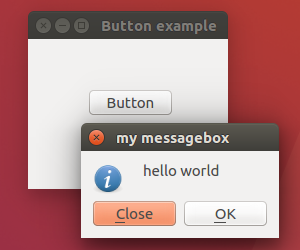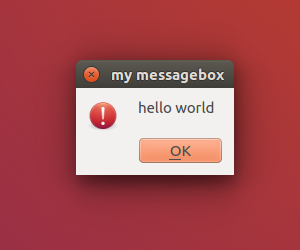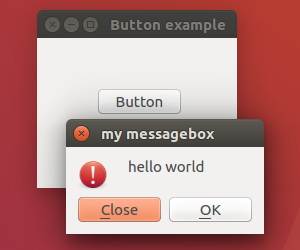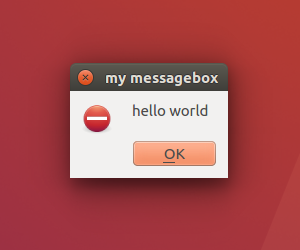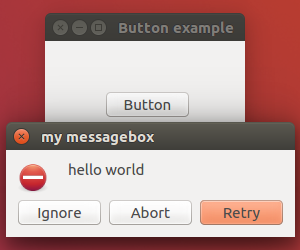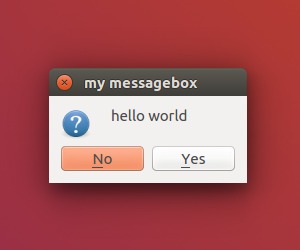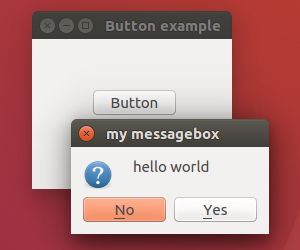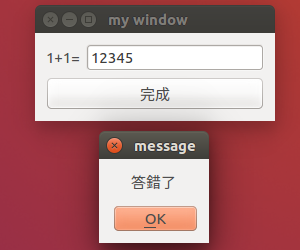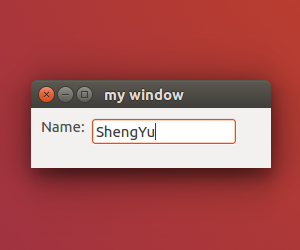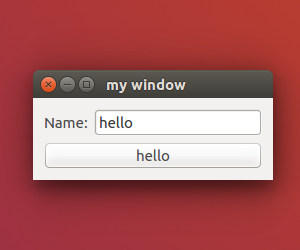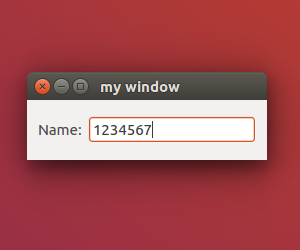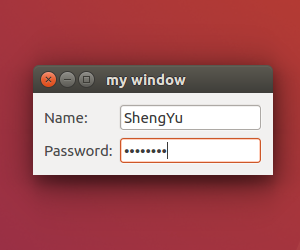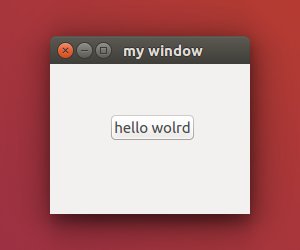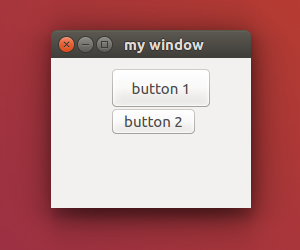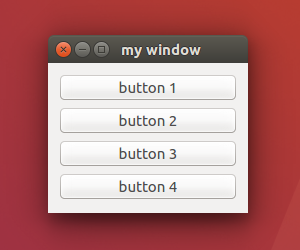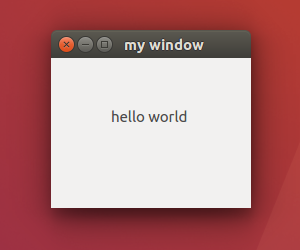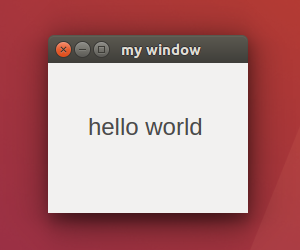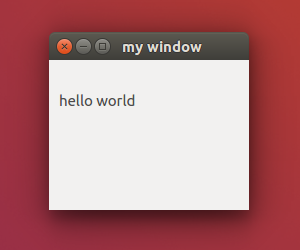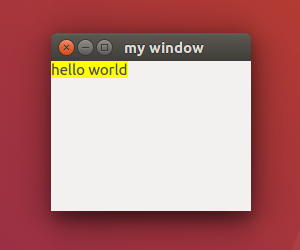本篇 ShengYu 介紹 Python PyQt5 QLineEdit 用法與範例,Python GUI 程式設計裡文字輸入框的處理是很基本且常用的功能,接下來就來學習怎麼用 PyQt5 建立 QLineEdit 吧!
以下的 Python PyQt5 QLineEdit 用法與範例將分為這幾部分,
PyQt5 QLineEdit 基本用法
PyQt5 取得 QLineEdit 的輸入文字
PyQt5 QLineEdit 限制只能輸入數字
PyQt5 QLineEdit 使用替代符號隱藏輸入密碼
PyQt5 QLineEdit 基本用法 這邊示範 PyQt5 QLineEdit 基本用法,QLineEdit() 初始化完以後,先用 move() 移到想要顯示的座標位置,如下例中的 mylabel 移到左邊 (10,10) 座標,mylineedit 移到右邊 (60,10) 座標,這樣的手動排版比較土炮一點,下個範例會介紹怎麼用 QGridLayout 來進行 UI 排版,接下來就使用 self.show() 就可以完成初步的 PyQt5 QLineEdit 體驗囉!範例如下,python-pyqt-qlineedit.py 1 2 3 4 5 6 7 8 9 10 11 12 13 14 15 16 17 18 19 20 21 22 23 24 25 import sysfrom PyQt5.QtWidgets import (QApplication, QWidget, QLineEdit, QLabel)class MyWidget (QWidget) : def __init__ (self) : super().__init__() self.initUI() def initUI (self) : self.setWindowTitle('my window' ) self.setGeometry(50 , 50 , 240 , 60 ) self.mylabel = QLabel('Name:' , self) self.mylabel.move(10 , 10 ) self.mylineedit = QLineEdit(self) self.mylineedit.move(60 , 10 ) if __name__ == '__main__' : app = QApplication(sys.argv) w = MyWidget() w.show() sys.exit(app.exec_())
結果圖如下,
PyQt5 取得 QLineEdit 的輸入文字 PyQt5 取得 QLineEdit 的輸入文字可以用 QLineEdit.text() 的方式,如下例子中的 mylineedit.text(),這邊示範按下按鈕時將 QLineEdit 裡的文字取出來後,並且設定成 mybutton 顯示的文字,python-pyqt-qlineedit2.py 1 2 3 4 5 6 7 8 9 10 11 12 13 14 15 16 17 18 19 20 21 22 23 24 25 26 27 28 29 30 31 32 33 34 35 36 37 38 import sysfrom PyQt5.QtWidgets import (QApplication, QWidget, QGridLayout, QLineEdit, QLabel, QPushButton) class MyWidget (QWidget) : def __init__ (self) : super().__init__() self.initUI() def initUI (self) : self.setWindowTitle('my window' ) self.setGeometry(50 , 50 , 240 , 80 ) gridlayout = QGridLayout() self.setLayout(gridlayout) self.mylabel = QLabel('Name:' , self) gridlayout.addWidget(self.mylabel, 0 , 0 ) self.mylineedit = QLineEdit(self) gridlayout.addWidget(self.mylineedit, 0 , 1 ) self.mybutton = QPushButton('button' , self) gridlayout.addWidget(self.mybutton, 1 , 0 , 1 , 2 ) self.mybutton.clicked.connect(self.onButtonClick) def onButtonClick (self) : if self.mylineedit.text() != '' : self.mybutton.setText(self.mylineedit.text()) if __name__ == '__main__' : app = QApplication(sys.argv) w = MyWidget() w.show() sys.exit(app.exec_())
這邊就使用 QGridLayout 來進行 UI 排版就不使用 move 了,QGridLayout.addWidget() 的 3 種函式參數介紹如下,1 2 3 QGridLayout.addWidget(QWidget) QGridLayout.addWidget(QWidget, int row, int column, Qt.Alignment alignment=0 ) QGridLayout.addWidget(QWidget, int row, int column, int rowSpan, int columnSpan, Qt.Alignment alignment=0 )
把 mylabel 放到 (0,0) 的位置,把 mylineedit 放到 (0,1) 的位置,把 mybutton 放到 (1,0) 的位置並且第 4 個引數 columnSpan 延伸為 2,
輸入文字且按下按鈕的結果圖如下,
這邊改用另一個例子,我們寫一個簡單的數學問題,讓使用者來回答,python-pyqt-qlineedit3.py 1 2 3 4 5 6 7 8 9 10 11 12 13 14 15 16 17 18 19 20 21 22 23 24 25 26 27 28 29 30 31 32 33 34 35 36 37 38 39 40 41 42 import sysfrom PyQt5.QtWidgets import (QApplication, QWidget, QGridLayout, QLineEdit, QLabel, QPushButton, QMessageBox) class MyWidget (QWidget) : def __init__ (self) : super().__init__() self.initUI() def initUI (self) : self.setWindowTitle('my window' ) self.setGeometry(50 , 50 , 240 , 80 ) gridlayout = QGridLayout() self.setLayout(gridlayout) self.mylabel = QLabel('1+1=' , self) gridlayout.addWidget(self.mylabel, 0 , 0 ) self.mylineedit = QLineEdit(self) gridlayout.addWidget(self.mylineedit, 0 , 1 ) self.mybutton = QPushButton('完成' , self) gridlayout.addWidget(self.mybutton, 1 , 0 , 1 , 2 ) self.mybutton.clicked.connect(self.onButtonClick) def onButtonClick (self) : if self.mylineedit.text() == '' : QMessageBox.about(self, 'message' , '未輸入答案' ) elif self.mylineedit.text() == '2' : QMessageBox.about(self, 'message' , '答對了' ) else : QMessageBox.about(self, 'message' , '答錯了' ) if __name__ == '__main__' : app = QApplication(sys.argv) w = MyWidget() w.show() sys.exit(app.exec_())
結果圖如下,這篇 介紹。
PyQt5 QLineEdit 限制只能輸入數字 這邊介紹蠻常使用到的功能,就是限制使用者只能在 QLineEdit 裡輸入數字,需要在 mylineedit 設定一個 QIntValidator() 它會去驗證輸入的文字是不是整數,本例中是限制使用者只能輸入數字,用法如下,python-pyqt-qlineedit4.py 1 2 3 4 5 6 7 8 9 10 11 12 13 14 15 16 17 18 19 20 21 22 23 24 25 26 27 28 29 30 31 import sysfrom PyQt5.QtWidgets import (QApplication, QWidget, QGridLayout, QLineEdit, QLabel) from PyQt5.QtGui import QIntValidatorclass MyWidget (QWidget) : def __init__ (self) : super().__init__() self.initUI() def initUI (self) : self.setWindowTitle('my window' ) self.setGeometry(50 , 50 , 240 , 60 ) gridlayout = QGridLayout() self.setLayout(gridlayout) self.mylabel = QLabel('Name:' , self) gridlayout.addWidget(self.mylabel, 0 , 0 ) self.mylineedit = QLineEdit(self) gridlayout.addWidget(self.mylineedit, 0 , 1 ) self.mylineedit.setValidator(QIntValidator()) if __name__ == '__main__' : app = QApplication(sys.argv) w = MyWidget() w.show() sys.exit(app.exec_())
結果圖如下,
QIntValidator() 還能限制你輸入的整數範圍,例如 0~255,以及限制使用者只能輸入 double,這方面的詳細內容可以看 PyQt5 QLineEdit 限制輸入數字 這篇介紹。
PyQt5 QLineEdit 使用替代符號隱藏輸入密碼 這邊示範一個登入視窗,裡面有兩個 QLineEdit,分別是要讓使用者輸入使用者名稱與密碼,我們希望使用者輸入的密碼不要用明碼顯示出來,取而代之的是用替代符號來顯示,那要怎麼作呢?就是在 QLineEdit.setEchoMode() 裡設定 QLineEdit.Password 參數,這樣輸入時就會顯示替代符號而不會顯示明碼了,範例如下,python-pyqt-qlineedit5.py 1 2 3 4 5 6 7 8 9 10 11 12 13 14 15 16 17 18 19 20 21 22 23 24 25 26 27 28 29 30 31 32 33 34 import sysfrom PyQt5.QtWidgets import (QApplication, QWidget, QGridLayout, QLineEdit, QLabel) class MyWidget (QWidget) : def __init__ (self) : super().__init__() self.initUI() def initUI (self) : self.setWindowTitle('my window' ) self.setGeometry(50 , 50 , 240 , 60 ) gridlayout = QGridLayout() self.setLayout(gridlayout) self.mylabel = QLabel('Name:' , self) gridlayout.addWidget(self.mylabel, 0 , 0 ) self.mylineedit = QLineEdit(self) gridlayout.addWidget(self.mylineedit, 0 , 1 ) self.mylabel2 = QLabel('Password:' , self) gridlayout.addWidget(self.mylabel2, 1 , 0 ) self.mylineedit2 = QLineEdit(self) self.mylineedit2.setEchoMode(QLineEdit.Password) gridlayout.addWidget(self.mylineedit2, 1 , 1 ) if __name__ == '__main__' : app = QApplication(sys.argv) w = MyWidget() w.show() sys.exit(app.exec_())
結果圖如下,
以上就是 Python PyQt5 QLineEdit 文字輸入框的介紹,Facebook 按讚 支持一下!PyQt5 QComboBox 下拉式選單用法與範例
其它相關文章推薦 Python QLabel 標籤用法與範例 Python QPushButton 按鈕用法與範例 Python 新手入門教學懶人包 Python PyQt5 新手入門教學

